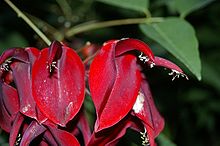- Erythrina crista-galli
-
Cockspur Coral Tree 
Flowers Conservation status Scientific classification Kingdom: Plantae (unranked): Angiosperms (unranked): Eudicots (unranked): Rosids Order: Fabales Family: Fabaceae Genus: Erythrina Species: E. crista-galli Binomial name Erythrina crista-galli
L.Synonyms Many, see text
Erythrina crista-galli is a flowering tree in the family Fabaceae, native to Argentina, Uruguay, Brazil and Paraguay. It is widely planted as a street or garden tree in other countries, most notably in California (in the United States). It is known by several common names within South America: ceibo, seíbo (Spanish), corticeira (Portuguese) and the more ambiguous bucaré, to name a few. In English it is often known as the Cockspur Coral Tree.
The tree's flower is the national flower of Argentina (since 23 December 1942) and Uruguay.
This species characteristically grows wild in gallery forest ecosystems along watercourses, as well as in swamps and wetlands. In urban settings, it is often planted in parks for its bright red flowers.
Contents
Description
Erythrina crista-galli is a small tree, the girth of its trunk measuring 50 cm (20 in). Normally it grows 5–8 m (16–26 ft) tall, although some individuals, such as in the Argentine provinces of Salta, Jujuy and Tucumán, can grow up to 10 m (33 ft).
The root is a taproot with nodules produced by nitrogen fixing bacteria. The bacteria live in symbiosis with the tree, facilitating the tree's absorption of nitrogen in return for organic substances which the bacteria need. The tree's trunk is woody with irregular, spiny branches. These branches form a layer without definite form[verification needed] and die after flowering.
The tree flowers in the summer, from October to April in their native South America and from April to October in the northern hemisphere. It Usually blooms from November to February The red flower, arranged in inflorescences of the raceme type, is pentameric, complete, and of bilateral symmetry. Its calyx is gamosepalous, like a little red thimble. The corolla, like that of other legumes like common beans, is butterfly-shaped; however, the largest petal, called the "standard", is arranged in the lower part. The two of the petals called "wings" are so small that they are practically hidden within the calyx. The remaining two petals partially fuse together on occasion and form the flower's keel or "carina"; this protects its reproductive organs. The androecium consists of ten stamens, one free and nine united by their filaments (gynostemial androecium). The unicarpel gynoecium is welded between the stamens like a knife in its sheath.
The flowers are rich in nectar and get visited by insects, which usually have to crawl underneath the carina and thus pollinate the flowers.
The tree's fruit is monocarpic and dry, of the legume type, and no more than a few centimeters in length. The chestnut-brown seeds are cylindrical in form and are arranged sparsely throughout the seedpod's interior. The seed germ contains hypogeous cotyledons - the seeds stay underground upon germination.
Synonyms
Synonyms are as follows:[1]
- Corallodendron crista-galli (L.) Kuntze
- Erythrina crista-galli L. var. hasskarlii Backer
- Erythrina crista-galli L. var. leucochlora A.Lombardo
- Erythrina fasciculata Benth.
- Erythrina laurifolia Jacq.
- Erythrina pulcherrima Tod.
- Erythrina speciosa Tod.
- E. speciosa Andrews is a distinct species
- Micropteryx crista-galli Walp.[verification needed]
- Micropteryx fasciculata Walp.[verification needed]
- Micropteryx laurifolia Walp.[verification needed]
References
- This article draws heavily on the corresponding article in the Spanish-language Wikipedia.
- ^ International Legume Database & Information Service (ILDIS) (2005): Erythrina crista-galli. Version 10.01, November 2005. Retrieved 26 January 2008.
- Pink, Alfred (1904): Gardening for the Million. Fisher Unwin, London. TXT and HTML fulltexts at Project Gutenberg.
External links
- John Stephen Glasby, Dictionary of Plants Containing Secondary Metabolites, Published by CRC Press
- Images of Legume, Seeds - Flavon's Wild herb and Alpine plants
- (Spanish) Día de la Flor Nacional - "National Flower Day", in Argentina's Ministry of Health and Environment website (scientific description, pictures).
 National emblems of Argentina
National emblems of ArgentinaCoat of arms · Father of the fatherland · National animal · National anthem · National cockade · National dish · National flag · National flower · National liquor · National motto · National personification · National sport · National stone · Official logo · Patron saint · Provincial flags · Sun of May
Categories:- NatureServe Apparently Secure species
- Erythrina
- National symbols of Argentina
- National symbols of Uruguay
- Trees of Argentina
- Trees of Brazil
- Trees of Paraguay
- Trees of Uruguay
Wikimedia Foundation. 2010.


